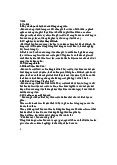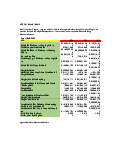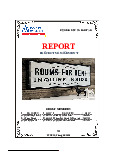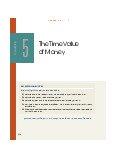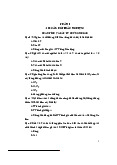





Preview text:
1. What is the present value (i.e., price) today of a bond that will pay its owner
$1,000,000 five years from today if the discount rate is 4% per annum?
Ans: This is called a zero-coupon or pure discount bond $1,000,000 P V = FV = = $ 9 5 5 821, 27.11 Bond (1+r) (1+4%)
2. Assume that a bond makes 30 equal annual payments of $1,000 starting one year
from today. If the discount rate is 3.5% per annum, what is the current price of the
bond? Face value of bond is $10,000
Ans: Recognize that this cash flow stream is an annuity and that the price of an
asset is the present value of its future cash flows.
Current price of bond = P V = C * [1 − 1 ] + FV = $1,000 [ − 1 ] + $10,000 n n * 1 r (1+r) (1+r) 3.5% (1+3.5%)30 (1+3.5%)30 = $18, 9 3 2.05 + 3 $ , 6 5 2.78 = $21, 954.83
3. Coupon Bond: Assume that a bond makes 10 equal annual payments of $1,000
starting one year from today. The bond will make an additional payment of
$100,000 at the end of the last year, year 10. If the discount rate is 3.5% per
annum, what is the current price of the bond? Ans:
Current price of bond = P V = C * 1
[ − 1 ] + FV = $1,000 [ − 1 ] + 100,000 n n * 1 r (1+r) (1+r) 3.5% (1+3.5%)10 (1+3.5%)10 = $8, 316.61 + $70, 9 8 1.88 = $79, 208.49
4. The price of a US government issued five year zero coupon bond, with a face
value of $1000, is $744.09. What is the yield to maturity of the bond if the interest is compounded yearly? Answer: P rice of zero − o c upon bond = P V = F V (1+r)n P V = $744.09 F V = $1, 000 n = 5 => Y ield to maturity = . 6 09%
5. What is the market value of a 20-year bond with face value of $1000, which
makes quarterly coupon payments at a coupon rate of 10%, if the required rate of
return is 8% per year, compounded quarterly? Ans: n = 0 2 years * 4 = 80 periods c = 0
1 %/year = 10% = 2.5%/quarter => = 2 $ 0 = $ 4 C = c * F V .5% * 1, 00 25 r = % 8 /year = 2%/quarter F V = $1, 000 a
m rket value of bond = P V = C * [1 − 1 ] + FV = $25 ] + $1,000 n n * 1 [ − 1 r (1+r) (1+r) 2% (1+2%)80 (1+2%)80 = $993.61 + 2 $ 05.11 = $1, 198.72
6. You have just purchased a newly issued $1,000 five-year Vanguard Company
bond at par. This five-year bond pays $60 in semi-annual coupon payments. You
are also considering the purchase of another Vanguard Company bond that pays
$30 in semi- annual coupons and has six years remaining before maturity. This
bond also has a face value of $1000. Both bonds make coupon payments semiannually.
What is the yield-to-maturity on the five-year bond? Answer: Bond 1: (five-year bond) F V = $1, 000 a m rket value = P V = 1 $ , 0 0 0 n = 5 years * 2 = 10 periods Coupon payment = $60 Because Market value = F
V , yield to maturity = coupon rate =
Coupon payment of a year = $60 2 * = 12% F ace V alue $1000
7. Refer back to Question 6. What is the effective annual yield on the five-year bond? Answer: 2
EAR = (1 + r )m − 1 = (1 + 12% ) − 1 = 1 2.36% m 2
8. Refer back to Question 6. Assume that the five-year bond and the six-year bond
have the same yield. What should you be willing to pay for the six-year bond? Answer:
Bond 2 : the same company issuer as Bond 1, at the same time F V = $1, 000 n = 6 years * 2 = 12 periods
Coupon payment = $30 semi-annual
yield to maturity of bond 2 = r = 12% = % 6 2
M arket value of bond 2 = P V = C * [1 − 1 ] + FV = 30 ] + $1,000 n n r (1+r) (1+r) 6% * 1 [ − 1 (1+6%)12 (1+6%)12 = $251.52 + $ 496.97 = $748.49
9. Suppose that you purchased a 15-year bond that pays semi-annual coupon of $20
and is currently selling at par. What would your realized annual return be if you
sold the bond five years later when the yield is 5.5%? Assume the face value of the bond is $1,000. Ans: F V = $1, 000
P rice you buy the bond = market value = P V = F V = $1, 000 n = 5 1 years * 2 = 30 periods Coupon payment = $20
T he price you sell the bond f ive years later when the yield is 5.5% =
P V = C * [1 − 1 ] + FV = $20 [ − 1 ] + $1,000 = $ + n n 283.44 $581.25 r (1+r) (1+r) 2.75% * 1 (1+2.75%)20 (1+2.75%)20 = $864.69
Realized rate of return = $20 1 * 0+864.69−1000 = . 6 5%/5years 1000 n
A nual Realized rate of return = + 6 − 1 = . 1 27% √5(1 .5%)
